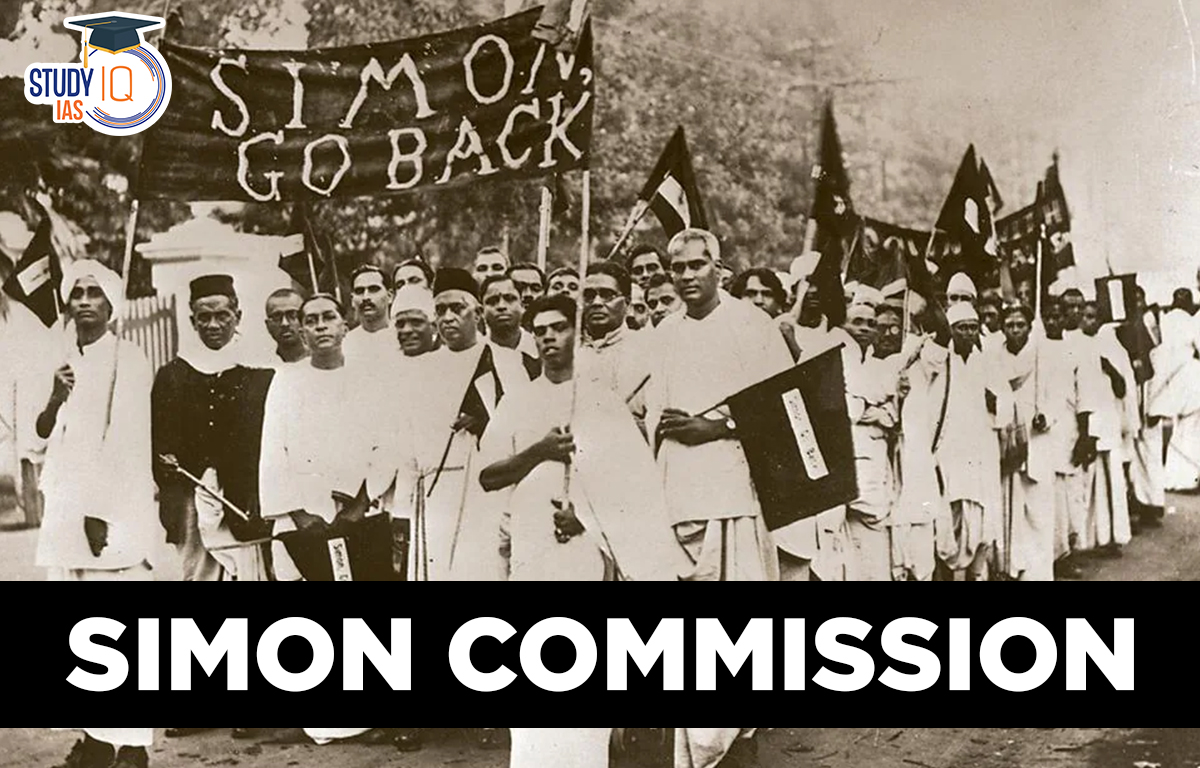Table of Contents
Simon Commission
The Simon Commission, also known as the Indian Statutory Commission, is a team chosen to research India’s proposed constitutional changes. The Government of India Act of 1919 established the Indian constitution, which was the subject of a report by the Simon Commission. Sir John Simon served as the appointing authority for the Simon Commission.
Since no Indians were included, the Simon Commission faced harsh criticism. The Indian National Congress and the majority of other Indian political parties boycotted the panel. The UPSC/IAS Exam Modern History of India syllabus includes the subject “Simon Commission,” which is covered in-depth in this article.
Simon Commission History
The Government of India Act of 1919 made the announcement that a royal commission would be established in ten years from 1919 to provide a report on the effectiveness of the act. In India, the Government of India Act of 1919 established diarchy. The Act also stated that a commission would be established after ten years to assess the effectiveness and advancement of the measures implemented as a result of the Act. Indian elites and the general populace favored reforming the diarchy system of government.
The establishment of a commission was accelerated in 1928 despite the 1919 Act stating that it was only required in 1929 because the Conservative Party-led government in the UK anticipated a defeat at the hands of the Labour Party in the forthcoming elections. There was not a single Indian member of the Commission, which was made up completely of British members. Indians, who had a point when they said that a small group of British people could not decide what would become of them, were considered to have been insulted by this.
Lord Birkenhead, the Secretary of State for India, had criticised Indians for what he regarded to be their failure to develop a specific reform plan through agreement among all segments of the Indian political scene. The Commission was established at the direction of Lord Birkenhead. One of the Commission’s members was Clement Atlee. He later rose to the position of Prime Minister of Britain during the 1947 partition and independence of India.
What is Simon Commission?
Seven members of Parliament served on the Indian Statutory Commission, often known as the Simon Commission, which was presided over by Sir John Simon. In order to research constitutional reform in Britain’s largest and most significant possession, India, the commission landed there in 1928.
Simon Commission Recommendations
In its place, representative governments will be established in the provinces to replace the Diarchy system of governance. It recommended maintaining the distinct electorates until community animosity and violence decreased.
A “Council of Greater India” was proposed as the central organisation, reflecting the interests of both British India and the princely states. It advocated allocating seats to the most disadvantaged groups. The Governor was given unrestricted authority in order to uphold intergroup animosity, rifts, and internet security.
The idea was put forth to raise the size of the Legislative Council. The Commission should be included in the 1935 Government of India Act, according to the reforms. The High Court should be entirely under the supervision of the Government of India in order for it to be so.
Simon Commission’s Boycott
Indians were indignant over being left off of the Commission. At their meeting in Madras in 1927, the Congress Party made the decision to boycott the Commission. Additionally, the Muslim League under M. A. Jinnah abstained. Members under the leadership of Muhammad Shafi backed the administration. In the South, the Justice Party made the decision to support the administration on this matter.
There were widespread protests, hartals, and black flag demonstrations when the Commission arrived in February 1928. “Simon Go Back” was being chanted by the crowd. To put an end to the movement, the police used lathi charges. Even powerful individuals like Pandit Nehru were not exempt.
Lala Lajpat Rai, who was in command of the protest against the Simon Commission in Lahore, was viciously attacked with a lathi. Due to wounds received at the time, he passed away later that year. On behalf of the Bahishkrita Hitakarini Sabha, Dr. B. R. Ambedkar submitted a report on the education of the underprivileged sections in the Bombay Presidency.
Simon Commission Impacts
The report of the Commission was released in 1930. Prior to publication, the administration gave the assurance that going forward, Indian opinion would be taken into consideration and that dominion status for India would follow naturally from constitutional improvements. It proposed ending the diarchy and establishing representative governments in the provinces.
Additionally, it suggested keeping distinct electorates for each community until hostilities between them had subsided. The Government of India Act of 1935, which served as the foundation for several provisions of the current Indian Constitution, was the result of the Simon Commission. In 1937, the first provincial elections were held, and Congress governments were installed in nearly all of the provinces. The Commission’s arrival energized leaders and the general public, giving the Indian independence movement a boost.
Simon Commission FAQs
Q) When Simon Commission did first came to India?
Ans. The Indian Statutory Commission, commonly referred to as the Simon Commission after its chairman Sir John Allsebrook Simon, was sent to India in 1928 (February – March and October 1928 – April 1929) to study potential constitutional reform.
Q) What was the purpose of the Simon Commission?
Ans. The British government set up a commission to enquire into the government of India act of 1919. The aim of the commission was to enquire into the working of the act and to suggest further reforms in the system of administration. The commission was therefore named after Sir John Simon who headed it.
Q) What was Simon Commission and why was it opposed?
Ans. The objective of the Simon Commission was to review the working of the Government of India Act 1919 and decide the political future of India.
Q) Who declared Simon Commission?
Ans. This report advocated that India be given dominion status with complete internal self-government. Jinnah declared the report as “Hindu Document” and presented Fourteen Points of Jinnah in response to the Nehru Report.
Q) Who coined the slogan Simon go back?
Ans. The slogan “Simon Go Back” and “Quit India” were created by Yusuf Meherally, a lesser-known hero of India’s war for independence.


 Nagari Pracharini Sabha Revival: Backgro...
Nagari Pracharini Sabha Revival: Backgro...
 Ryotwari System in India, Features, Impa...
Ryotwari System in India, Features, Impa...
 Battle of Plassey, History, Causes, Impa...
Battle of Plassey, History, Causes, Impa...





















